Taxation Law: Sale of Assets and Depreciation of Assets
VerifiedAdded on 2022/10/14
|12
|2918
|291
AI Summary
This document explains the taxation laws related to the sale of assets such as main home, car, cleaning business, furniture, and paintings. It also discusses the depreciation of assets and the deduction for the outgoings that are occurred at the time of creating or generating taxable earnings.
Contribute Materials
Your contribution can guide someone’s learning journey. Share your
documents today.
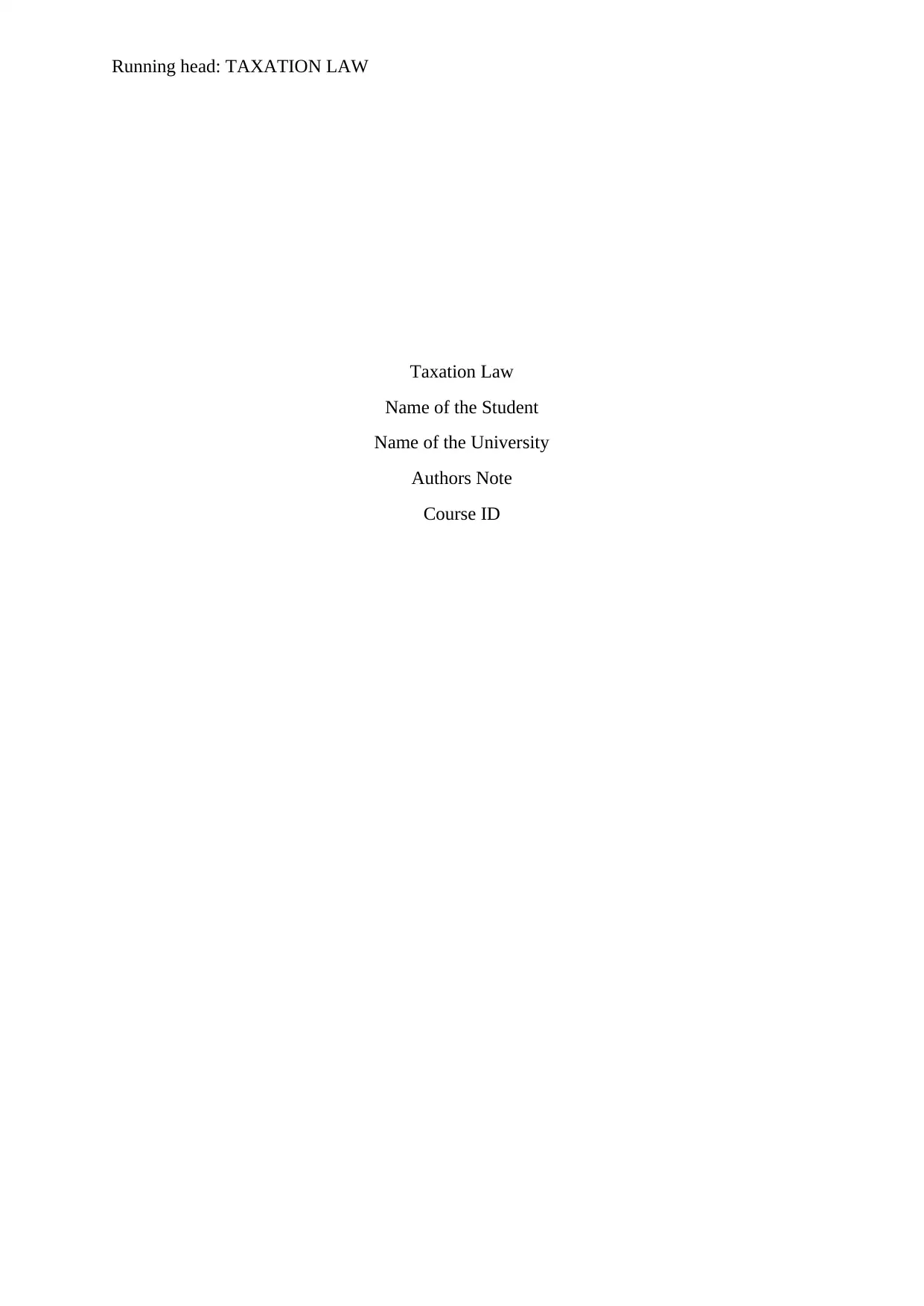
Running head: TAXATION LAW
Taxation Law
Name of the Student
Name of the University
Authors Note
Course ID
Taxation Law
Name of the Student
Name of the University
Authors Note
Course ID
Secure Best Marks with AI Grader
Need help grading? Try our AI Grader for instant feedback on your assignments.
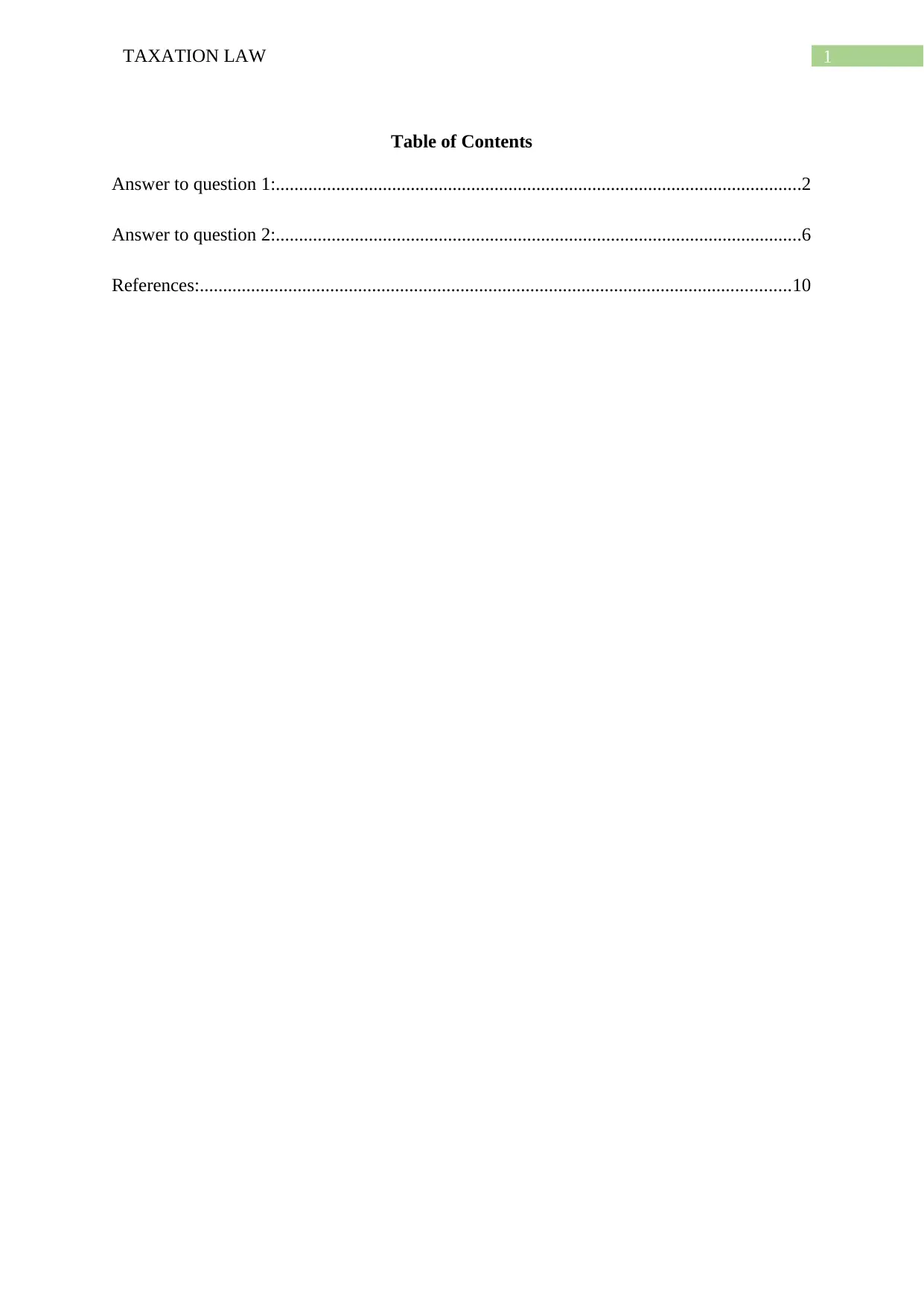
1TAXATION LAW
Table of Contents
Answer to question 1:.................................................................................................................2
Answer to question 2:.................................................................................................................6
References:...............................................................................................................................10
Table of Contents
Answer to question 1:.................................................................................................................2
Answer to question 2:.................................................................................................................6
References:...............................................................................................................................10
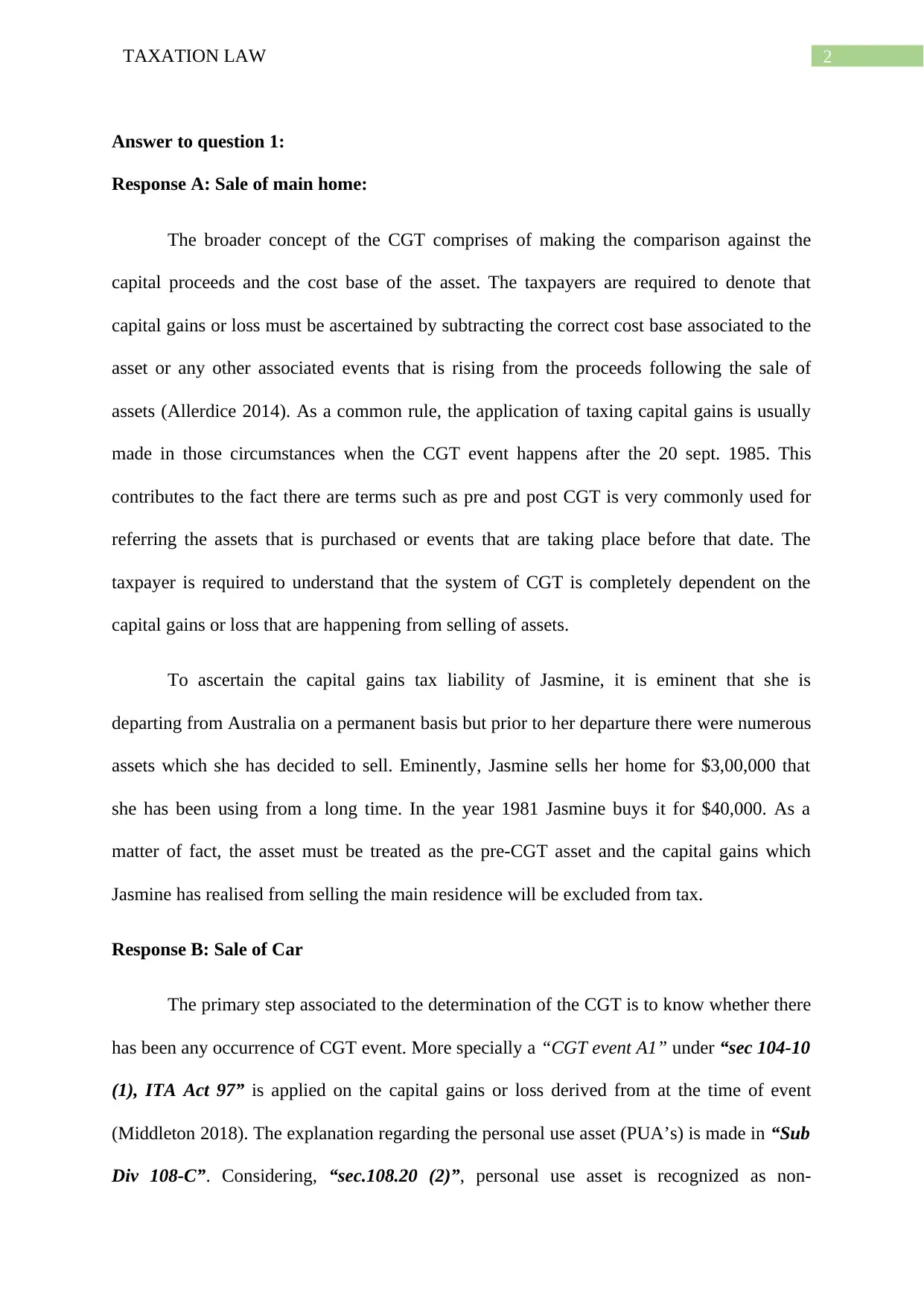
2TAXATION LAW
Answer to question 1:
Response A: Sale of main home:
The broader concept of the CGT comprises of making the comparison against the
capital proceeds and the cost base of the asset. The taxpayers are required to denote that
capital gains or loss must be ascertained by subtracting the correct cost base associated to the
asset or any other associated events that is rising from the proceeds following the sale of
assets (Allerdice 2014). As a common rule, the application of taxing capital gains is usually
made in those circumstances when the CGT event happens after the 20 sept. 1985. This
contributes to the fact there are terms such as pre and post CGT is very commonly used for
referring the assets that is purchased or events that are taking place before that date. The
taxpayer is required to understand that the system of CGT is completely dependent on the
capital gains or loss that are happening from selling of assets.
To ascertain the capital gains tax liability of Jasmine, it is eminent that she is
departing from Australia on a permanent basis but prior to her departure there were numerous
assets which she has decided to sell. Eminently, Jasmine sells her home for $3,00,000 that
she has been using from a long time. In the year 1981 Jasmine buys it for $40,000. As a
matter of fact, the asset must be treated as the pre-CGT asset and the capital gains which
Jasmine has realised from selling the main residence will be excluded from tax.
Response B: Sale of Car
The primary step associated to the determination of the CGT is to know whether there
has been any occurrence of CGT event. More specially a “CGT event A1” under “sec 104-10
(1), ITA Act 97” is applied on the capital gains or loss derived from at the time of event
(Middleton 2018). The explanation regarding the personal use asset (PUA’s) is made in “Sub
Div 108-C”. Considering, “sec.108.20 (2)”, personal use asset is recognized as non-
Answer to question 1:
Response A: Sale of main home:
The broader concept of the CGT comprises of making the comparison against the
capital proceeds and the cost base of the asset. The taxpayers are required to denote that
capital gains or loss must be ascertained by subtracting the correct cost base associated to the
asset or any other associated events that is rising from the proceeds following the sale of
assets (Allerdice 2014). As a common rule, the application of taxing capital gains is usually
made in those circumstances when the CGT event happens after the 20 sept. 1985. This
contributes to the fact there are terms such as pre and post CGT is very commonly used for
referring the assets that is purchased or events that are taking place before that date. The
taxpayer is required to understand that the system of CGT is completely dependent on the
capital gains or loss that are happening from selling of assets.
To ascertain the capital gains tax liability of Jasmine, it is eminent that she is
departing from Australia on a permanent basis but prior to her departure there were numerous
assets which she has decided to sell. Eminently, Jasmine sells her home for $3,00,000 that
she has been using from a long time. In the year 1981 Jasmine buys it for $40,000. As a
matter of fact, the asset must be treated as the pre-CGT asset and the capital gains which
Jasmine has realised from selling the main residence will be excluded from tax.
Response B: Sale of Car
The primary step associated to the determination of the CGT is to know whether there
has been any occurrence of CGT event. More specially a “CGT event A1” under “sec 104-10
(1), ITA Act 97” is applied on the capital gains or loss derived from at the time of event
(Middleton 2018). The explanation regarding the personal use asset (PUA’s) is made in “Sub
Div 108-C”. Considering, “sec.108.20 (2)”, personal use asset is recognized as non-
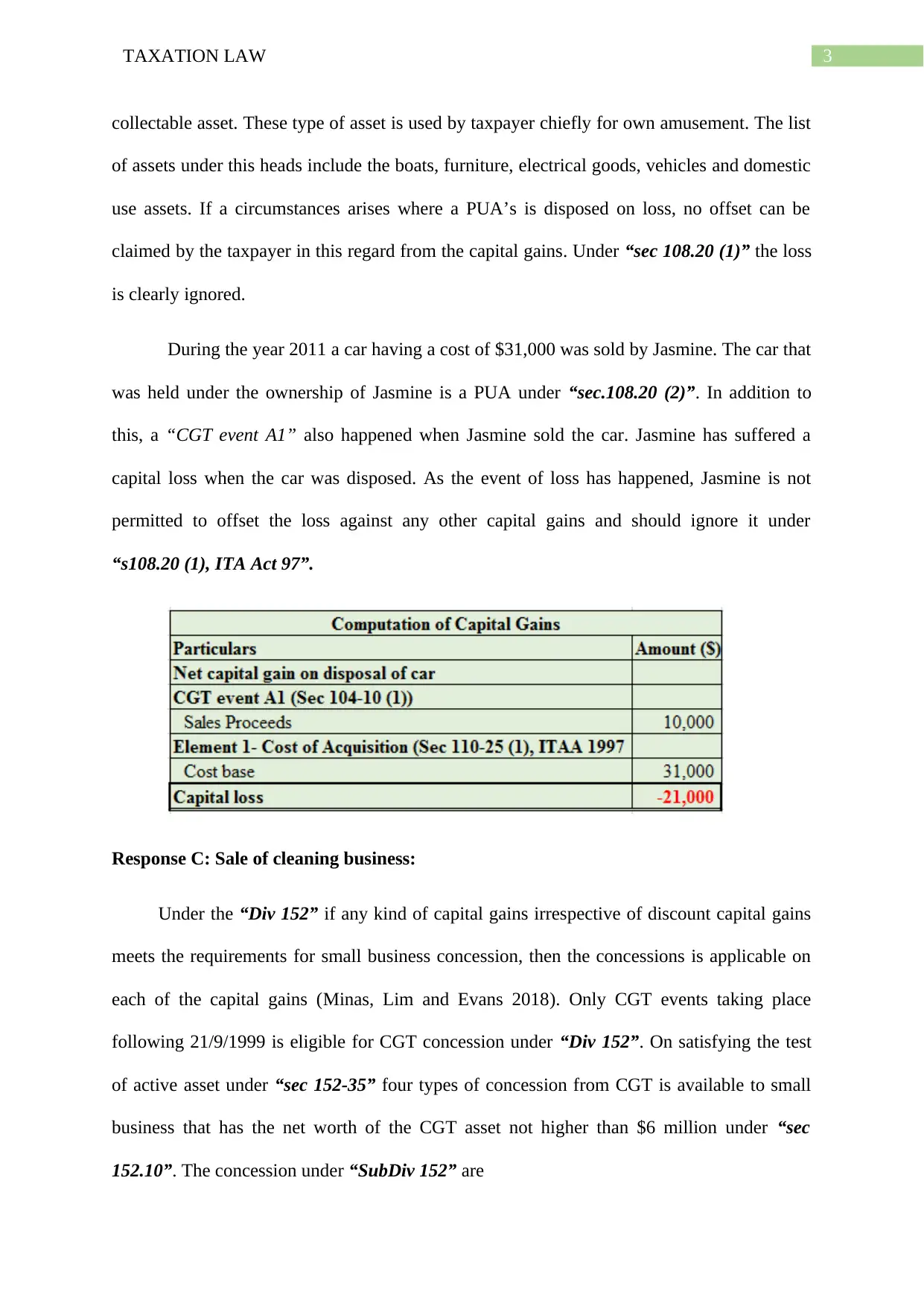
3TAXATION LAW
collectable asset. These type of asset is used by taxpayer chiefly for own amusement. The list
of assets under this heads include the boats, furniture, electrical goods, vehicles and domestic
use assets. If a circumstances arises where a PUA’s is disposed on loss, no offset can be
claimed by the taxpayer in this regard from the capital gains. Under “sec 108.20 (1)” the loss
is clearly ignored.
During the year 2011 a car having a cost of $31,000 was sold by Jasmine. The car that
was held under the ownership of Jasmine is a PUA under “sec.108.20 (2)”. In addition to
this, a “CGT event A1” also happened when Jasmine sold the car. Jasmine has suffered a
capital loss when the car was disposed. As the event of loss has happened, Jasmine is not
permitted to offset the loss against any other capital gains and should ignore it under
“s108.20 (1), ITA Act 97”.
Response C: Sale of cleaning business:
Under the “Div 152” if any kind of capital gains irrespective of discount capital gains
meets the requirements for small business concession, then the concessions is applicable on
each of the capital gains (Minas, Lim and Evans 2018). Only CGT events taking place
following 21/9/1999 is eligible for CGT concession under “Div 152”. On satisfying the test
of active asset under “sec 152-35” four types of concession from CGT is available to small
business that has the net worth of the CGT asset not higher than $6 million under “sec
152.10”. The concession under “SubDiv 152” are
collectable asset. These type of asset is used by taxpayer chiefly for own amusement. The list
of assets under this heads include the boats, furniture, electrical goods, vehicles and domestic
use assets. If a circumstances arises where a PUA’s is disposed on loss, no offset can be
claimed by the taxpayer in this regard from the capital gains. Under “sec 108.20 (1)” the loss
is clearly ignored.
During the year 2011 a car having a cost of $31,000 was sold by Jasmine. The car that
was held under the ownership of Jasmine is a PUA under “sec.108.20 (2)”. In addition to
this, a “CGT event A1” also happened when Jasmine sold the car. Jasmine has suffered a
capital loss when the car was disposed. As the event of loss has happened, Jasmine is not
permitted to offset the loss against any other capital gains and should ignore it under
“s108.20 (1), ITA Act 97”.
Response C: Sale of cleaning business:
Under the “Div 152” if any kind of capital gains irrespective of discount capital gains
meets the requirements for small business concession, then the concessions is applicable on
each of the capital gains (Minas, Lim and Evans 2018). Only CGT events taking place
following 21/9/1999 is eligible for CGT concession under “Div 152”. On satisfying the test
of active asset under “sec 152-35” four types of concession from CGT is available to small
business that has the net worth of the CGT asset not higher than $6 million under “sec
152.10”. The concession under “SubDiv 152” are
Secure Best Marks with AI Grader
Need help grading? Try our AI Grader for instant feedback on your assignments.
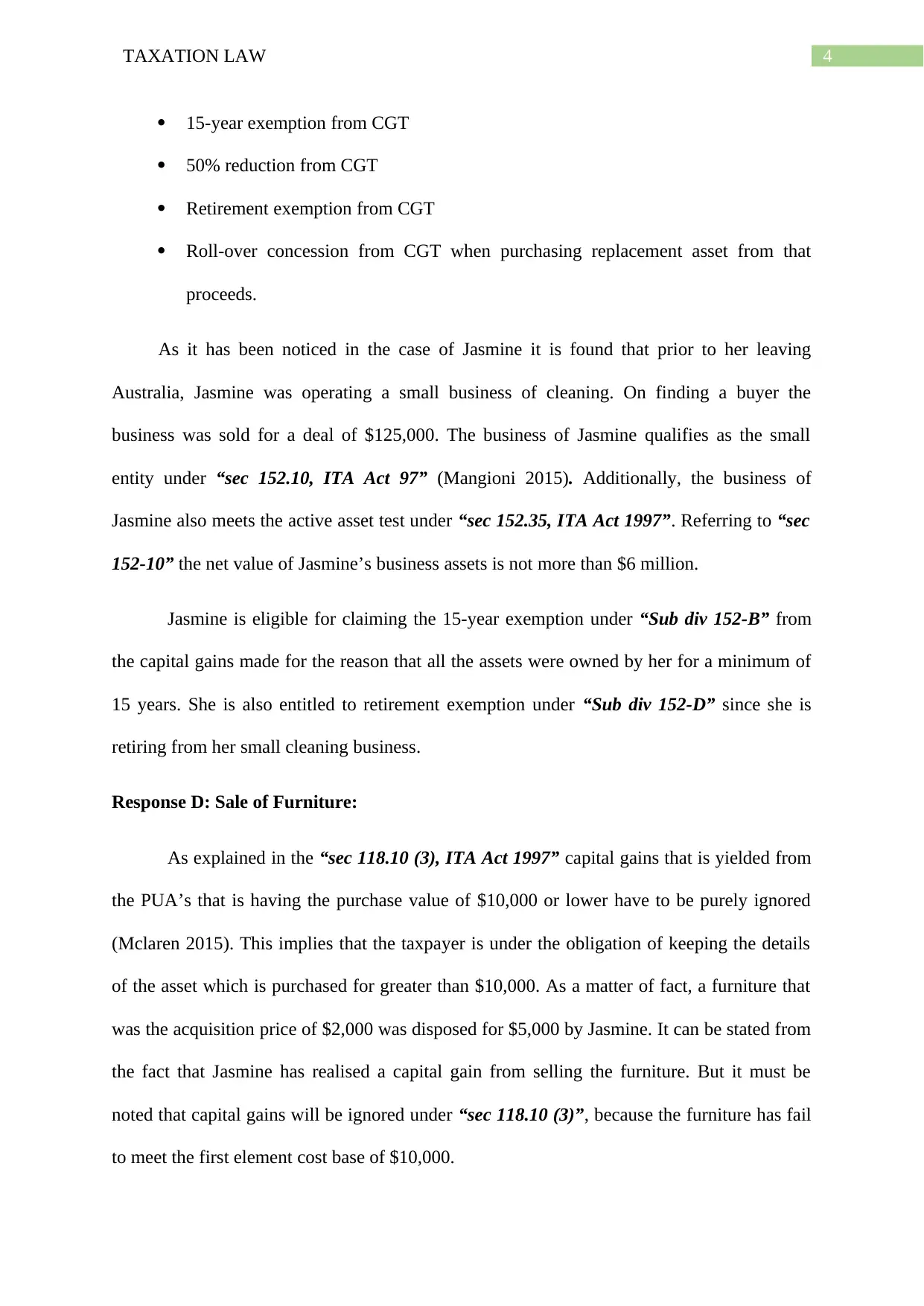
4TAXATION LAW
15-year exemption from CGT
50% reduction from CGT
Retirement exemption from CGT
Roll-over concession from CGT when purchasing replacement asset from that
proceeds.
As it has been noticed in the case of Jasmine it is found that prior to her leaving
Australia, Jasmine was operating a small business of cleaning. On finding a buyer the
business was sold for a deal of $125,000. The business of Jasmine qualifies as the small
entity under “sec 152.10, ITA Act 97” (Mangioni 2015). Additionally, the business of
Jasmine also meets the active asset test under “sec 152.35, ITA Act 1997”. Referring to “sec
152-10” the net value of Jasmine’s business assets is not more than $6 million.
Jasmine is eligible for claiming the 15-year exemption under “Sub div 152-B” from
the capital gains made for the reason that all the assets were owned by her for a minimum of
15 years. She is also entitled to retirement exemption under “Sub div 152-D” since she is
retiring from her small cleaning business.
Response D: Sale of Furniture:
As explained in the “sec 118.10 (3), ITA Act 1997” capital gains that is yielded from
the PUA’s that is having the purchase value of $10,000 or lower have to be purely ignored
(Mclaren 2015). This implies that the taxpayer is under the obligation of keeping the details
of the asset which is purchased for greater than $10,000. As a matter of fact, a furniture that
was the acquisition price of $2,000 was disposed for $5,000 by Jasmine. It can be stated from
the fact that Jasmine has realised a capital gain from selling the furniture. But it must be
noted that capital gains will be ignored under “sec 118.10 (3)”, because the furniture has fail
to meet the first element cost base of $10,000.
15-year exemption from CGT
50% reduction from CGT
Retirement exemption from CGT
Roll-over concession from CGT when purchasing replacement asset from that
proceeds.
As it has been noticed in the case of Jasmine it is found that prior to her leaving
Australia, Jasmine was operating a small business of cleaning. On finding a buyer the
business was sold for a deal of $125,000. The business of Jasmine qualifies as the small
entity under “sec 152.10, ITA Act 97” (Mangioni 2015). Additionally, the business of
Jasmine also meets the active asset test under “sec 152.35, ITA Act 1997”. Referring to “sec
152-10” the net value of Jasmine’s business assets is not more than $6 million.
Jasmine is eligible for claiming the 15-year exemption under “Sub div 152-B” from
the capital gains made for the reason that all the assets were owned by her for a minimum of
15 years. She is also entitled to retirement exemption under “Sub div 152-D” since she is
retiring from her small cleaning business.
Response D: Sale of Furniture:
As explained in the “sec 118.10 (3), ITA Act 1997” capital gains that is yielded from
the PUA’s that is having the purchase value of $10,000 or lower have to be purely ignored
(Mclaren 2015). This implies that the taxpayer is under the obligation of keeping the details
of the asset which is purchased for greater than $10,000. As a matter of fact, a furniture that
was the acquisition price of $2,000 was disposed for $5,000 by Jasmine. It can be stated from
the fact that Jasmine has realised a capital gain from selling the furniture. But it must be
noted that capital gains will be ignored under “sec 118.10 (3)”, because the furniture has fail
to meet the first element cost base of $10,000.
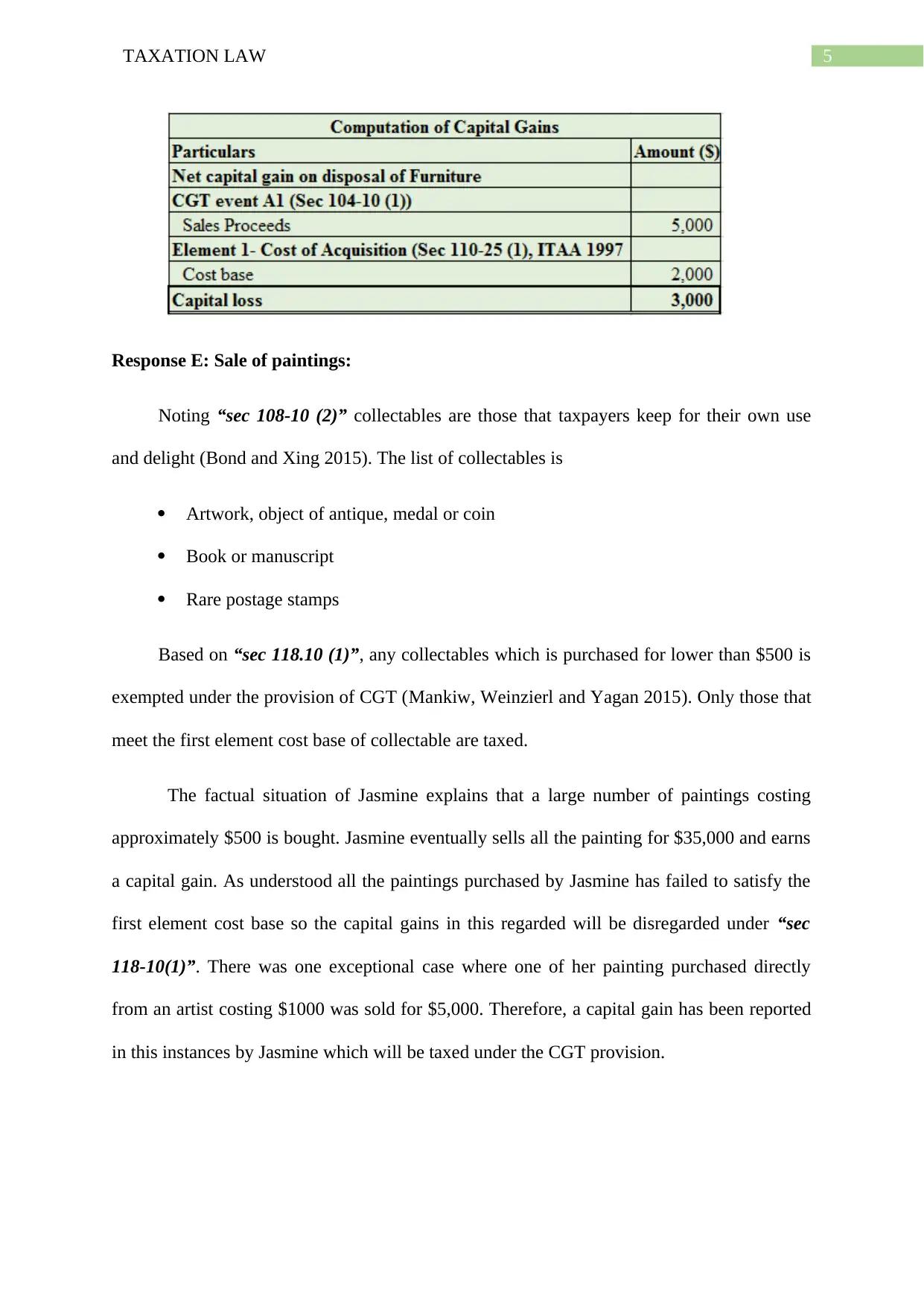
5TAXATION LAW
Response E: Sale of paintings:
Noting “sec 108-10 (2)” collectables are those that taxpayers keep for their own use
and delight (Bond and Xing 2015). The list of collectables is
Artwork, object of antique, medal or coin
Book or manuscript
Rare postage stamps
Based on “sec 118.10 (1)”, any collectables which is purchased for lower than $500 is
exempted under the provision of CGT (Mankiw, Weinzierl and Yagan 2015). Only those that
meet the first element cost base of collectable are taxed.
The factual situation of Jasmine explains that a large number of paintings costing
approximately $500 is bought. Jasmine eventually sells all the painting for $35,000 and earns
a capital gain. As understood all the paintings purchased by Jasmine has failed to satisfy the
first element cost base so the capital gains in this regarded will be disregarded under “sec
118-10(1)”. There was one exceptional case where one of her painting purchased directly
from an artist costing $1000 was sold for $5,000. Therefore, a capital gain has been reported
in this instances by Jasmine which will be taxed under the CGT provision.
Response E: Sale of paintings:
Noting “sec 108-10 (2)” collectables are those that taxpayers keep for their own use
and delight (Bond and Xing 2015). The list of collectables is
Artwork, object of antique, medal or coin
Book or manuscript
Rare postage stamps
Based on “sec 118.10 (1)”, any collectables which is purchased for lower than $500 is
exempted under the provision of CGT (Mankiw, Weinzierl and Yagan 2015). Only those that
meet the first element cost base of collectable are taxed.
The factual situation of Jasmine explains that a large number of paintings costing
approximately $500 is bought. Jasmine eventually sells all the painting for $35,000 and earns
a capital gain. As understood all the paintings purchased by Jasmine has failed to satisfy the
first element cost base so the capital gains in this regarded will be disregarded under “sec
118-10(1)”. There was one exceptional case where one of her painting purchased directly
from an artist costing $1000 was sold for $5,000. Therefore, a capital gain has been reported
in this instances by Jasmine which will be taxed under the CGT provision.
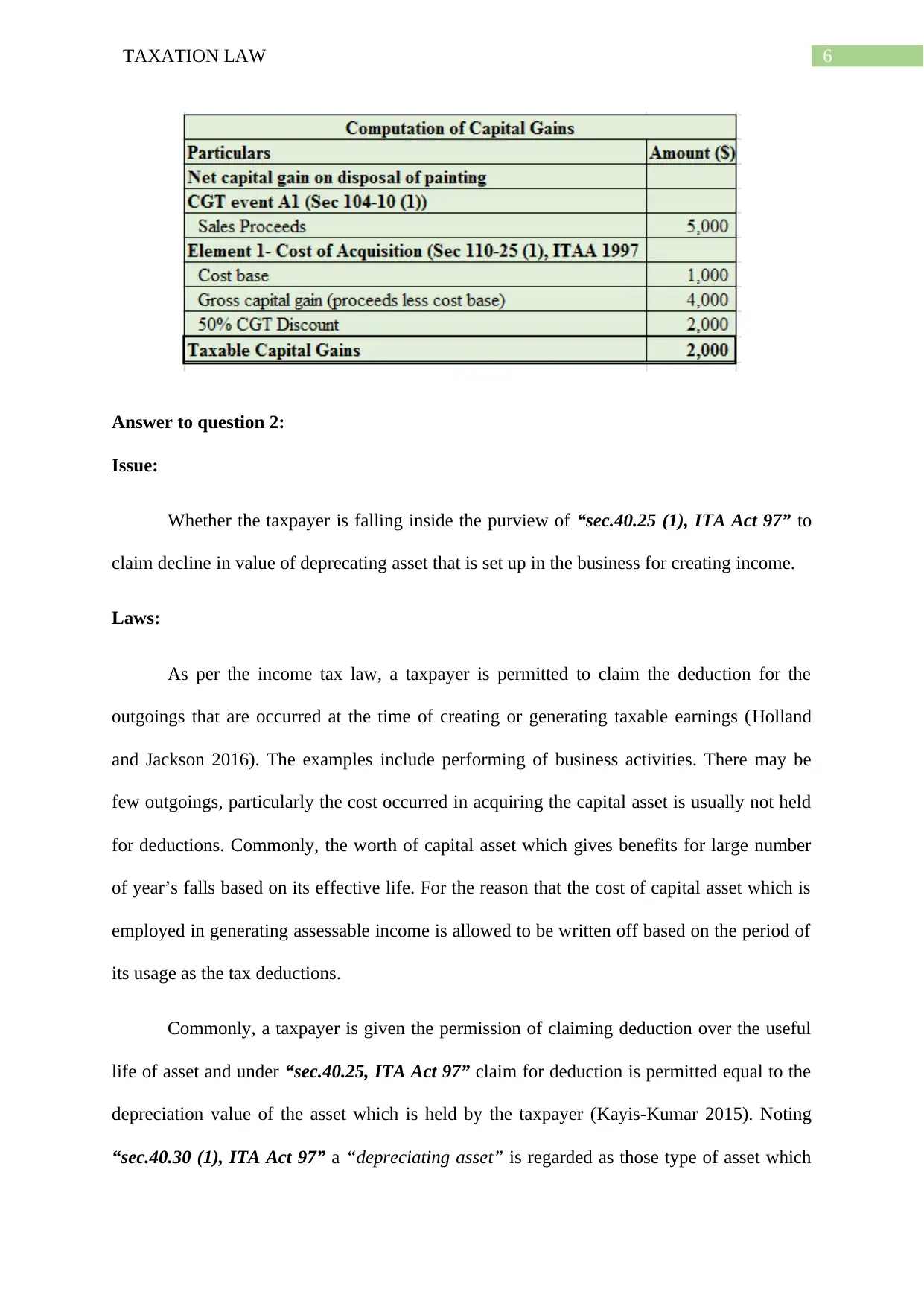
6TAXATION LAW
Answer to question 2:
Issue:
Whether the taxpayer is falling inside the purview of “sec.40.25 (1), ITA Act 97” to
claim decline in value of deprecating asset that is set up in the business for creating income.
Laws:
As per the income tax law, a taxpayer is permitted to claim the deduction for the
outgoings that are occurred at the time of creating or generating taxable earnings (Holland
and Jackson 2016). The examples include performing of business activities. There may be
few outgoings, particularly the cost occurred in acquiring the capital asset is usually not held
for deductions. Commonly, the worth of capital asset which gives benefits for large number
of year’s falls based on its effective life. For the reason that the cost of capital asset which is
employed in generating assessable income is allowed to be written off based on the period of
its usage as the tax deductions.
Commonly, a taxpayer is given the permission of claiming deduction over the useful
life of asset and under “sec.40.25, ITA Act 97” claim for deduction is permitted equal to the
depreciation value of the asset which is held by the taxpayer (Kayis-Kumar 2015). Noting
“sec.40.30 (1), ITA Act 97” a “depreciating asset” is regarded as those type of asset which
Answer to question 2:
Issue:
Whether the taxpayer is falling inside the purview of “sec.40.25 (1), ITA Act 97” to
claim decline in value of deprecating asset that is set up in the business for creating income.
Laws:
As per the income tax law, a taxpayer is permitted to claim the deduction for the
outgoings that are occurred at the time of creating or generating taxable earnings (Holland
and Jackson 2016). The examples include performing of business activities. There may be
few outgoings, particularly the cost occurred in acquiring the capital asset is usually not held
for deductions. Commonly, the worth of capital asset which gives benefits for large number
of year’s falls based on its effective life. For the reason that the cost of capital asset which is
employed in generating assessable income is allowed to be written off based on the period of
its usage as the tax deductions.
Commonly, a taxpayer is given the permission of claiming deduction over the useful
life of asset and under “sec.40.25, ITA Act 97” claim for deduction is permitted equal to the
depreciation value of the asset which is held by the taxpayer (Kayis-Kumar 2015). Noting
“sec.40.30 (1), ITA Act 97” a “depreciating asset” is regarded as those type of asset which
Paraphrase This Document
Need a fresh take? Get an instant paraphrase of this document with our AI Paraphraser
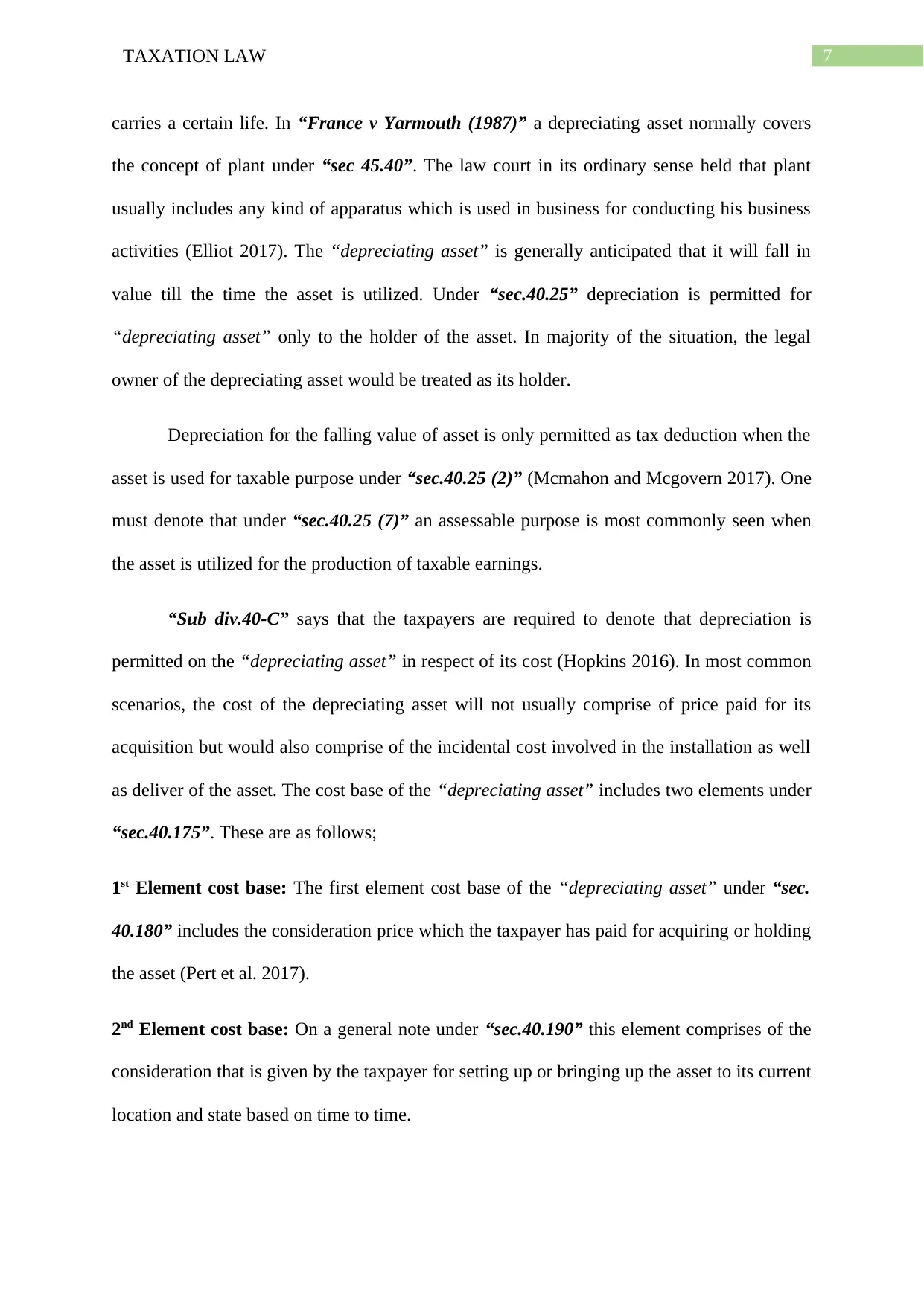
7TAXATION LAW
carries a certain life. In “France v Yarmouth (1987)” a depreciating asset normally covers
the concept of plant under “sec 45.40”. The law court in its ordinary sense held that plant
usually includes any kind of apparatus which is used in business for conducting his business
activities (Elliot 2017). The “depreciating asset” is generally anticipated that it will fall in
value till the time the asset is utilized. Under “sec.40.25” depreciation is permitted for
“depreciating asset” only to the holder of the asset. In majority of the situation, the legal
owner of the depreciating asset would be treated as its holder.
Depreciation for the falling value of asset is only permitted as tax deduction when the
asset is used for taxable purpose under “sec.40.25 (2)” (Mcmahon and Mcgovern 2017). One
must denote that under “sec.40.25 (7)” an assessable purpose is most commonly seen when
the asset is utilized for the production of taxable earnings.
“Sub div.40-C” says that the taxpayers are required to denote that depreciation is
permitted on the “depreciating asset” in respect of its cost (Hopkins 2016). In most common
scenarios, the cost of the depreciating asset will not usually comprise of price paid for its
acquisition but would also comprise of the incidental cost involved in the installation as well
as deliver of the asset. The cost base of the “depreciating asset” includes two elements under
“sec.40.175”. These are as follows;
1st Element cost base: The first element cost base of the “depreciating asset” under “sec.
40.180” includes the consideration price which the taxpayer has paid for acquiring or holding
the asset (Pert et al. 2017).
2nd Element cost base: On a general note under “sec.40.190” this element comprises of the
consideration that is given by the taxpayer for setting up or bringing up the asset to its current
location and state based on time to time.
carries a certain life. In “France v Yarmouth (1987)” a depreciating asset normally covers
the concept of plant under “sec 45.40”. The law court in its ordinary sense held that plant
usually includes any kind of apparatus which is used in business for conducting his business
activities (Elliot 2017). The “depreciating asset” is generally anticipated that it will fall in
value till the time the asset is utilized. Under “sec.40.25” depreciation is permitted for
“depreciating asset” only to the holder of the asset. In majority of the situation, the legal
owner of the depreciating asset would be treated as its holder.
Depreciation for the falling value of asset is only permitted as tax deduction when the
asset is used for taxable purpose under “sec.40.25 (2)” (Mcmahon and Mcgovern 2017). One
must denote that under “sec.40.25 (7)” an assessable purpose is most commonly seen when
the asset is utilized for the production of taxable earnings.
“Sub div.40-C” says that the taxpayers are required to denote that depreciation is
permitted on the “depreciating asset” in respect of its cost (Hopkins 2016). In most common
scenarios, the cost of the depreciating asset will not usually comprise of price paid for its
acquisition but would also comprise of the incidental cost involved in the installation as well
as deliver of the asset. The cost base of the “depreciating asset” includes two elements under
“sec.40.175”. These are as follows;
1st Element cost base: The first element cost base of the “depreciating asset” under “sec.
40.180” includes the consideration price which the taxpayer has paid for acquiring or holding
the asset (Pert et al. 2017).
2nd Element cost base: On a general note under “sec.40.190” this element comprises of the
consideration that is given by the taxpayer for setting up or bringing up the asset to its current
location and state based on time to time.
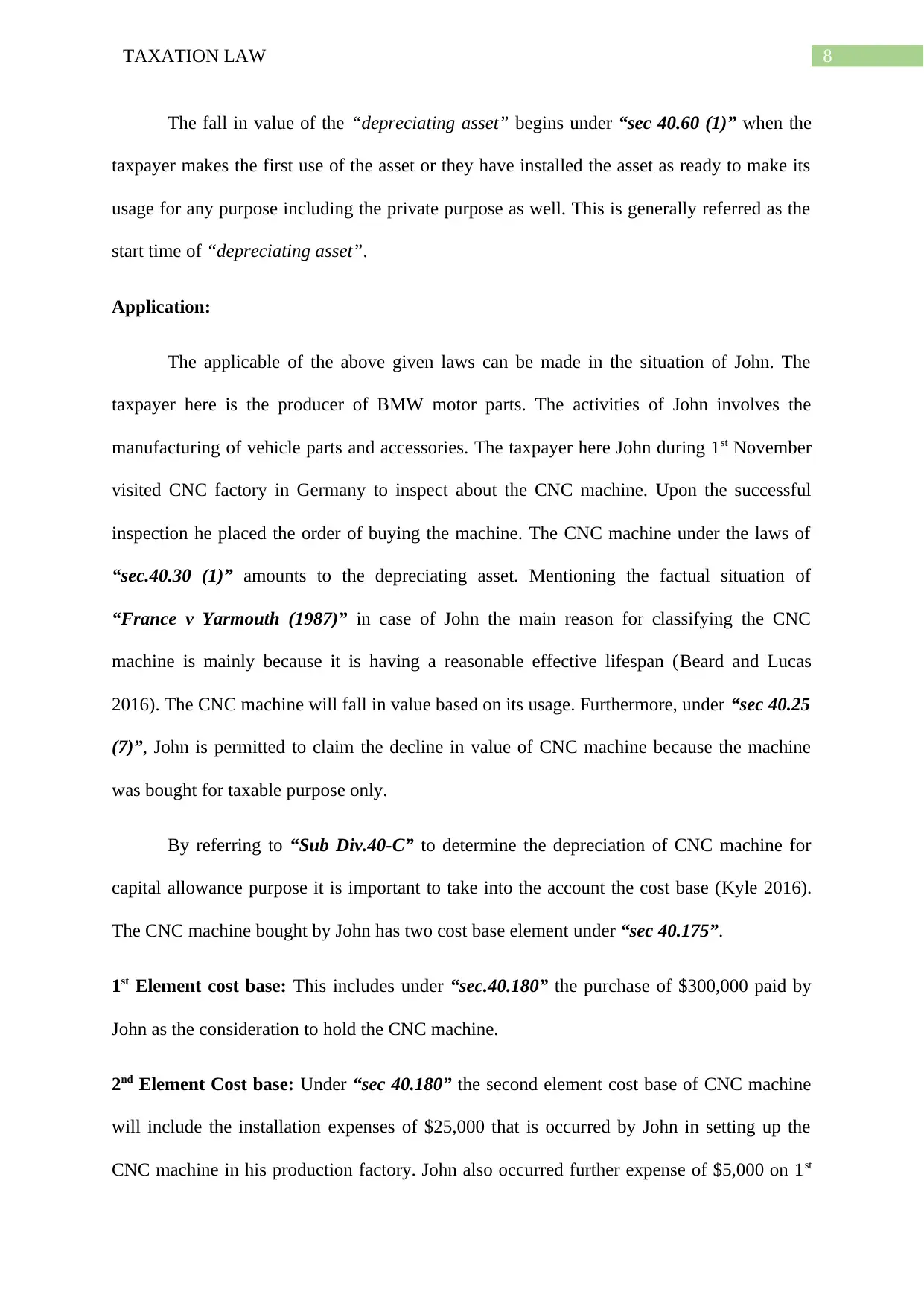
8TAXATION LAW
The fall in value of the “depreciating asset” begins under “sec 40.60 (1)” when the
taxpayer makes the first use of the asset or they have installed the asset as ready to make its
usage for any purpose including the private purpose as well. This is generally referred as the
start time of “depreciating asset”.
Application:
The applicable of the above given laws can be made in the situation of John. The
taxpayer here is the producer of BMW motor parts. The activities of John involves the
manufacturing of vehicle parts and accessories. The taxpayer here John during 1st November
visited CNC factory in Germany to inspect about the CNC machine. Upon the successful
inspection he placed the order of buying the machine. The CNC machine under the laws of
“sec.40.30 (1)” amounts to the depreciating asset. Mentioning the factual situation of
“France v Yarmouth (1987)” in case of John the main reason for classifying the CNC
machine is mainly because it is having a reasonable effective lifespan (Beard and Lucas
2016). The CNC machine will fall in value based on its usage. Furthermore, under “sec 40.25
(7)”, John is permitted to claim the decline in value of CNC machine because the machine
was bought for taxable purpose only.
By referring to “Sub Div.40-C” to determine the depreciation of CNC machine for
capital allowance purpose it is important to take into the account the cost base (Kyle 2016).
The CNC machine bought by John has two cost base element under “sec 40.175”.
1st Element cost base: This includes under “sec.40.180” the purchase of $300,000 paid by
John as the consideration to hold the CNC machine.
2nd Element Cost base: Under “sec 40.180” the second element cost base of CNC machine
will include the installation expenses of $25,000 that is occurred by John in setting up the
CNC machine in his production factory. John also occurred further expense of $5,000 on 1st
The fall in value of the “depreciating asset” begins under “sec 40.60 (1)” when the
taxpayer makes the first use of the asset or they have installed the asset as ready to make its
usage for any purpose including the private purpose as well. This is generally referred as the
start time of “depreciating asset”.
Application:
The applicable of the above given laws can be made in the situation of John. The
taxpayer here is the producer of BMW motor parts. The activities of John involves the
manufacturing of vehicle parts and accessories. The taxpayer here John during 1st November
visited CNC factory in Germany to inspect about the CNC machine. Upon the successful
inspection he placed the order of buying the machine. The CNC machine under the laws of
“sec.40.30 (1)” amounts to the depreciating asset. Mentioning the factual situation of
“France v Yarmouth (1987)” in case of John the main reason for classifying the CNC
machine is mainly because it is having a reasonable effective lifespan (Beard and Lucas
2016). The CNC machine will fall in value based on its usage. Furthermore, under “sec 40.25
(7)”, John is permitted to claim the decline in value of CNC machine because the machine
was bought for taxable purpose only.
By referring to “Sub Div.40-C” to determine the depreciation of CNC machine for
capital allowance purpose it is important to take into the account the cost base (Kyle 2016).
The CNC machine bought by John has two cost base element under “sec 40.175”.
1st Element cost base: This includes under “sec.40.180” the purchase of $300,000 paid by
John as the consideration to hold the CNC machine.
2nd Element Cost base: Under “sec 40.180” the second element cost base of CNC machine
will include the installation expenses of $25,000 that is occurred by John in setting up the
CNC machine in his production factory. John also occurred further expense of $5,000 on 1st
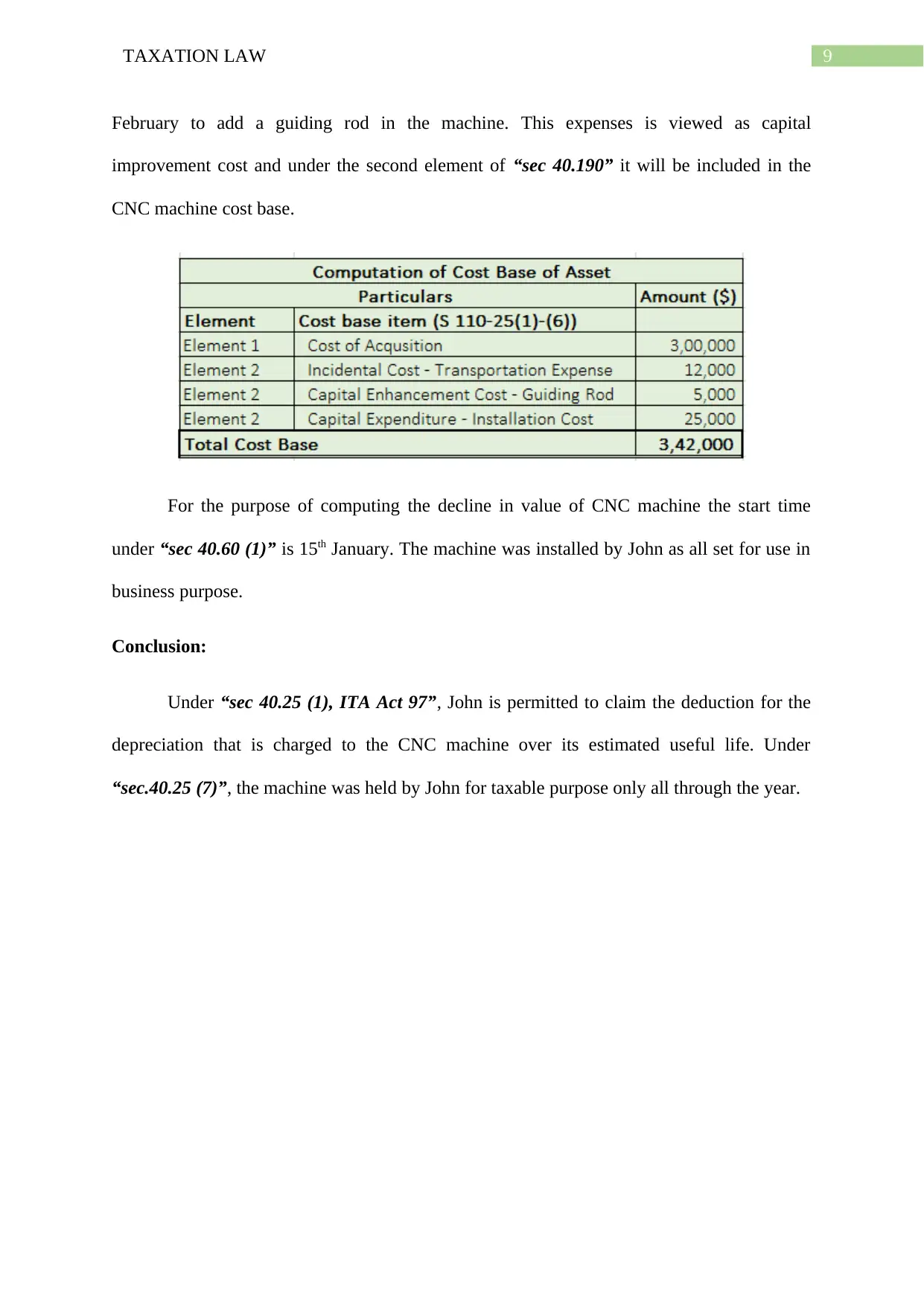
9TAXATION LAW
February to add a guiding rod in the machine. This expenses is viewed as capital
improvement cost and under the second element of “sec 40.190” it will be included in the
CNC machine cost base.
For the purpose of computing the decline in value of CNC machine the start time
under “sec 40.60 (1)” is 15th January. The machine was installed by John as all set for use in
business purpose.
Conclusion:
Under “sec 40.25 (1), ITA Act 97”, John is permitted to claim the deduction for the
depreciation that is charged to the CNC machine over its estimated useful life. Under
“sec.40.25 (7)”, the machine was held by John for taxable purpose only all through the year.
February to add a guiding rod in the machine. This expenses is viewed as capital
improvement cost and under the second element of “sec 40.190” it will be included in the
CNC machine cost base.
For the purpose of computing the decline in value of CNC machine the start time
under “sec 40.60 (1)” is 15th January. The machine was installed by John as all set for use in
business purpose.
Conclusion:
Under “sec 40.25 (1), ITA Act 97”, John is permitted to claim the deduction for the
depreciation that is charged to the CNC machine over its estimated useful life. Under
“sec.40.25 (7)”, the machine was held by John for taxable purpose only all through the year.
Secure Best Marks with AI Grader
Need help grading? Try our AI Grader for instant feedback on your assignments.
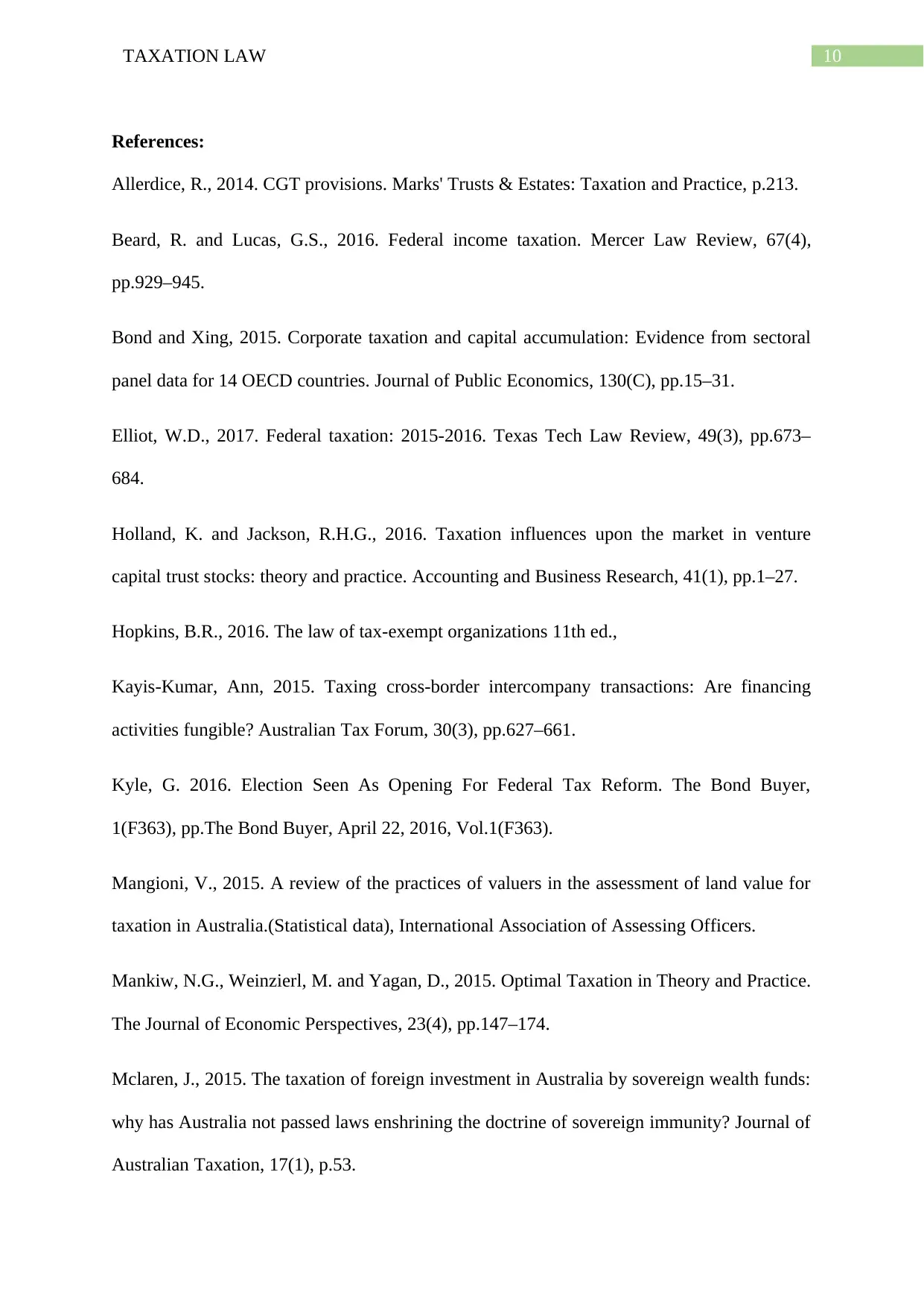
10TAXATION LAW
References:
Allerdice, R., 2014. CGT provisions. Marks' Trusts & Estates: Taxation and Practice, p.213.
Beard, R. and Lucas, G.S., 2016. Federal income taxation. Mercer Law Review, 67(4),
pp.929–945.
Bond and Xing, 2015. Corporate taxation and capital accumulation: Evidence from sectoral
panel data for 14 OECD countries. Journal of Public Economics, 130(C), pp.15–31.
Elliot, W.D., 2017. Federal taxation: 2015-2016. Texas Tech Law Review, 49(3), pp.673–
684.
Holland, K. and Jackson, R.H.G., 2016. Taxation influences upon the market in venture
capital trust stocks: theory and practice. Accounting and Business Research, 41(1), pp.1–27.
Hopkins, B.R., 2016. The law of tax-exempt organizations 11th ed.,
Kayis-Kumar, Ann, 2015. Taxing cross-border intercompany transactions: Are financing
activities fungible? Australian Tax Forum, 30(3), pp.627–661.
Kyle, G. 2016. Election Seen As Opening For Federal Tax Reform. The Bond Buyer,
1(F363), pp.The Bond Buyer, April 22, 2016, Vol.1(F363).
Mangioni, V., 2015. A review of the practices of valuers in the assessment of land value for
taxation in Australia.(Statistical data), International Association of Assessing Officers.
Mankiw, N.G., Weinzierl, M. and Yagan, D., 2015. Optimal Taxation in Theory and Practice.
The Journal of Economic Perspectives, 23(4), pp.147–174.
Mclaren, J., 2015. The taxation of foreign investment in Australia by sovereign wealth funds:
why has Australia not passed laws enshrining the doctrine of sovereign immunity? Journal of
Australian Taxation, 17(1), p.53.
References:
Allerdice, R., 2014. CGT provisions. Marks' Trusts & Estates: Taxation and Practice, p.213.
Beard, R. and Lucas, G.S., 2016. Federal income taxation. Mercer Law Review, 67(4),
pp.929–945.
Bond and Xing, 2015. Corporate taxation and capital accumulation: Evidence from sectoral
panel data for 14 OECD countries. Journal of Public Economics, 130(C), pp.15–31.
Elliot, W.D., 2017. Federal taxation: 2015-2016. Texas Tech Law Review, 49(3), pp.673–
684.
Holland, K. and Jackson, R.H.G., 2016. Taxation influences upon the market in venture
capital trust stocks: theory and practice. Accounting and Business Research, 41(1), pp.1–27.
Hopkins, B.R., 2016. The law of tax-exempt organizations 11th ed.,
Kayis-Kumar, Ann, 2015. Taxing cross-border intercompany transactions: Are financing
activities fungible? Australian Tax Forum, 30(3), pp.627–661.
Kyle, G. 2016. Election Seen As Opening For Federal Tax Reform. The Bond Buyer,
1(F363), pp.The Bond Buyer, April 22, 2016, Vol.1(F363).
Mangioni, V., 2015. A review of the practices of valuers in the assessment of land value for
taxation in Australia.(Statistical data), International Association of Assessing Officers.
Mankiw, N.G., Weinzierl, M. and Yagan, D., 2015. Optimal Taxation in Theory and Practice.
The Journal of Economic Perspectives, 23(4), pp.147–174.
Mclaren, J., 2015. The taxation of foreign investment in Australia by sovereign wealth funds:
why has Australia not passed laws enshrining the doctrine of sovereign immunity? Journal of
Australian Taxation, 17(1), p.53.
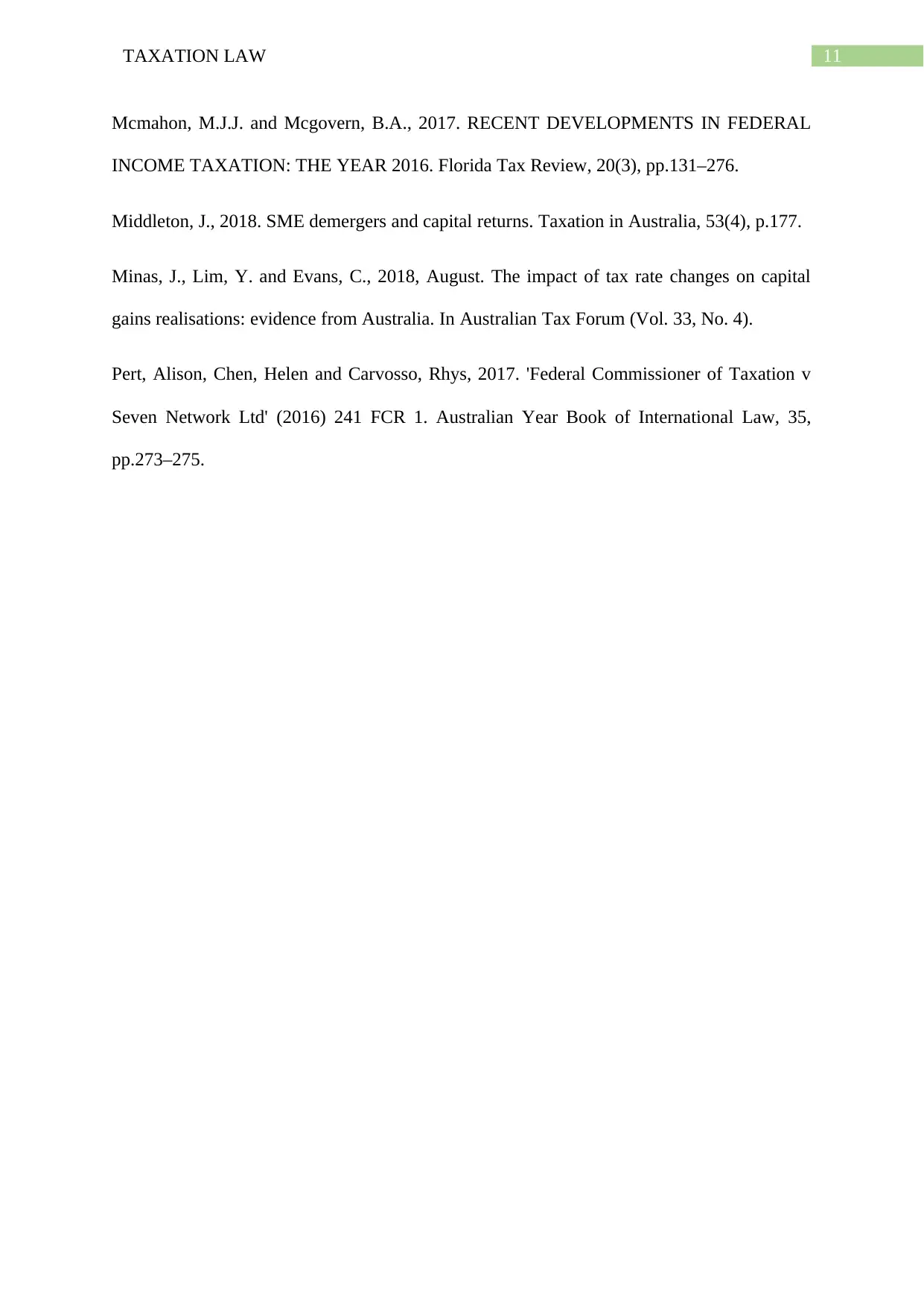
11TAXATION LAW
Mcmahon, M.J.J. and Mcgovern, B.A., 2017. RECENT DEVELOPMENTS IN FEDERAL
INCOME TAXATION: THE YEAR 2016. Florida Tax Review, 20(3), pp.131–276.
Middleton, J., 2018. SME demergers and capital returns. Taxation in Australia, 53(4), p.177.
Minas, J., Lim, Y. and Evans, C., 2018, August. The impact of tax rate changes on capital
gains realisations: evidence from Australia. In Australian Tax Forum (Vol. 33, No. 4).
Pert, Alison, Chen, Helen and Carvosso, Rhys, 2017. 'Federal Commissioner of Taxation v
Seven Network Ltd' (2016) 241 FCR 1. Australian Year Book of International Law, 35,
pp.273–275.
Mcmahon, M.J.J. and Mcgovern, B.A., 2017. RECENT DEVELOPMENTS IN FEDERAL
INCOME TAXATION: THE YEAR 2016. Florida Tax Review, 20(3), pp.131–276.
Middleton, J., 2018. SME demergers and capital returns. Taxation in Australia, 53(4), p.177.
Minas, J., Lim, Y. and Evans, C., 2018, August. The impact of tax rate changes on capital
gains realisations: evidence from Australia. In Australian Tax Forum (Vol. 33, No. 4).
Pert, Alison, Chen, Helen and Carvosso, Rhys, 2017. 'Federal Commissioner of Taxation v
Seven Network Ltd' (2016) 241 FCR 1. Australian Year Book of International Law, 35,
pp.273–275.
1 out of 12
Related Documents
Your All-in-One AI-Powered Toolkit for Academic Success.
+13062052269
info@desklib.com
Available 24*7 on WhatsApp / Email
![[object Object]](/_next/static/media/star-bottom.7253800d.svg)
Unlock your academic potential
© 2024 | Zucol Services PVT LTD | All rights reserved.





